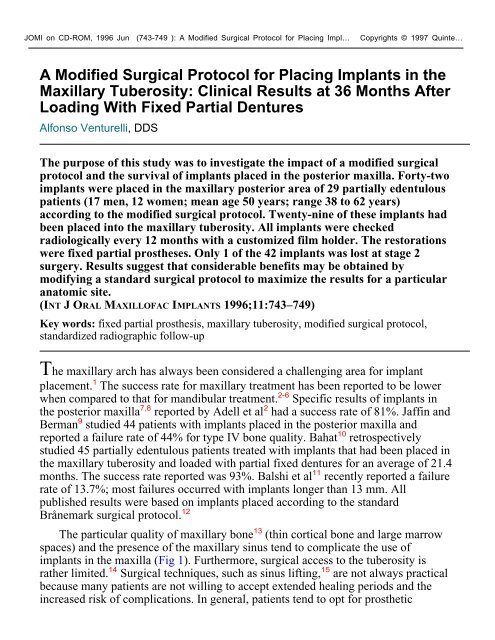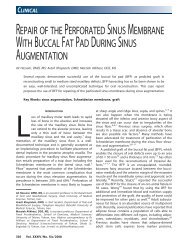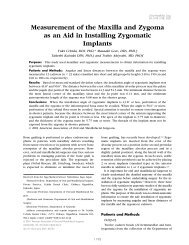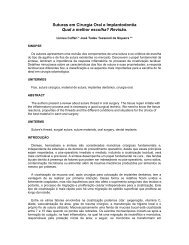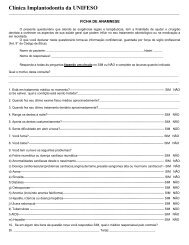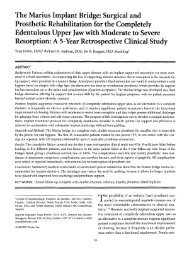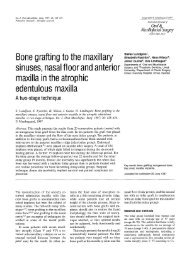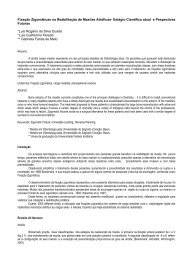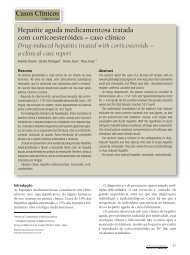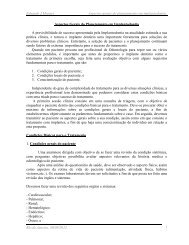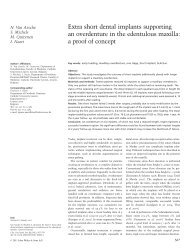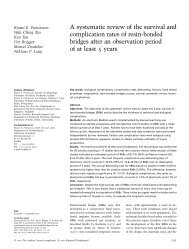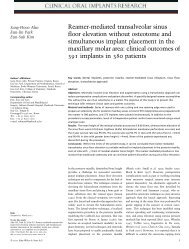A Modified Surgical Protocol for Placing Implants in the Maxillary ...
A Modified Surgical Protocol for Placing Implants in the Maxillary ...
A Modified Surgical Protocol for Placing Implants in the Maxillary ...
Create successful ePaper yourself
Turn your PDF publications into a flip-book with our unique Google optimized e-Paper software.
JOMI on CD-ROM, 1996 Jun (743-749 ): A <strong>Modified</strong> <strong>Surgical</strong> <strong>Protocol</strong> <strong>for</strong> <strong>Plac<strong>in</strong>g</strong> Impl…<br />
Copyrights © 1997 Qu<strong>in</strong>te…<br />
A <strong>Modified</strong> <strong>Surgical</strong> <strong>Protocol</strong> <strong>for</strong> <strong>Plac<strong>in</strong>g</strong> <strong>Implants</strong> <strong>in</strong> <strong>the</strong><br />
<strong>Maxillary</strong> Tuberosity: Cl<strong>in</strong>ical Results at 36 Months After<br />
Load<strong>in</strong>g With Fixed Partial Dentures<br />
Alfonso Venturelli, DDS<br />
The purpose of this study was to <strong>in</strong>vestigate <strong>the</strong> impact of a modified surgical<br />
protocol and <strong>the</strong> survival of implants placed <strong>in</strong> <strong>the</strong> posterior maxilla. Forty-two<br />
implants were placed <strong>in</strong> <strong>the</strong> maxillary posterior area of 29 partially edentulous<br />
patients (17 men, 12 women; mean age 50 years; range 38 to 62 years)<br />
accord<strong>in</strong>g to <strong>the</strong> modified surgical protocol. Twenty-n<strong>in</strong>e of <strong>the</strong>se implants had<br />
been placed <strong>in</strong>to <strong>the</strong> maxillary tuberosity. All implants were checked<br />
radiologically every 12 months with a customized film holder. The restorations<br />
were fixed partial pros<strong>the</strong>ses. Only 1 of <strong>the</strong> 42 implants was lost at stage 2<br />
surgery. Results suggest that considerable benefits may be obta<strong>in</strong>ed by<br />
modify<strong>in</strong>g a standard surgical protocol to maximize <strong>the</strong> results <strong>for</strong> a particular<br />
anatomic site.<br />
(INT J ORAL MAXILLOFAC IMPLANTS 1996;11:743–749)<br />
Key words: fixed partial pros<strong>the</strong>sis, maxillary tuberosity, modified surgical protocol,<br />
standardized radiographic follow-up<br />
The maxillary arch has always been considered a challeng<strong>in</strong>g area <strong>for</strong> implant<br />
placement.1 The success rate <strong>for</strong> maxillary treatment has been reported to be lower<br />
when compared to that <strong>for</strong> mandibular treatment.2-6 Specific results of implants <strong>in</strong><br />
<strong>the</strong> posterior maxilla7,8 reported by Adell et al2 had a success rate of 81%. Jaff<strong>in</strong> and<br />
Berman9 studied 44 patients with implants placed <strong>in</strong> <strong>the</strong> posterior maxilla and<br />
reported a failure rate of 44% <strong>for</strong> type IV bone quality. Bahat10 retrospectively<br />
studied 45 partially edentulous patients treated with implants that had been placed <strong>in</strong><br />
<strong>the</strong> maxillary tuberosity and loaded with partial fixed dentures <strong>for</strong> an average of 21.4<br />
months. The success rate reported was 93%. Balshi et al11 recently reported a failure<br />
rate of 13.7%; most failures occurred with implants longer than 13 mm. All<br />
published results were based on implants placed accord<strong>in</strong>g to <strong>the</strong> standard<br />
Brånemark surgical protocol.12<br />
The particular quality of maxillary bone13 (th<strong>in</strong> cortical bone and large marrow<br />
spaces) and <strong>the</strong> presence of <strong>the</strong> maxillary s<strong>in</strong>us tend to complicate <strong>the</strong> use of<br />
implants <strong>in</strong> <strong>the</strong> maxilla (Fig 1). Fur<strong>the</strong>rmore, surgical access to <strong>the</strong> tuberosity is<br />
ra<strong>the</strong>r limited.14 <strong>Surgical</strong> techniques, such as s<strong>in</strong>us lift<strong>in</strong>g,15 are not always practical<br />
because many patients are not will<strong>in</strong>g to accept extended heal<strong>in</strong>g periods and <strong>the</strong><br />
<strong>in</strong>creased risk of complications. In general, patients tend to opt <strong>for</strong> pros<strong>the</strong>tic
JOMI on CD-ROM, 1996 Jun (743-749 ): A <strong>Modified</strong> <strong>Surgical</strong> <strong>Protocol</strong> <strong>for</strong> <strong>Plac<strong>in</strong>g</strong> Impl…<br />
Copyrights © 1997 Qu<strong>in</strong>te…<br />
solutions more com<strong>for</strong>table than removable partial dentures and more functional<br />
than cantilevered pros<strong>the</strong>ses.<br />
Based on <strong>the</strong>se considerations, a modified surgical protocol <strong>for</strong> treatment of <strong>the</strong><br />
posterior maxilla is proposed and described <strong>in</strong> <strong>the</strong> present study. The cl<strong>in</strong>ical<br />
advantages of this protocol are discussed.<br />
Materials and Methods<br />
The present study reports <strong>the</strong> specific results of 42 implants placed <strong>in</strong> 29 patients (17<br />
men, 12 women; mean age 50 years; range 38 to 62 years) and loaded with fixed<br />
partial dentures <strong>for</strong> a mean period of 40 months (range 36 to 48 months). Of <strong>the</strong> 29<br />
patients, 19 received a s<strong>in</strong>gle implant <strong>in</strong> <strong>the</strong> tuberosity (Fig 2a), 7 received two<br />
implants (Fig 2b), and 3 received three implants (Fig 2c). Of <strong>the</strong> 42 implants, 29<br />
were placed <strong>in</strong>to <strong>the</strong> tuberosity; <strong>the</strong> o<strong>the</strong>r 13 were placed <strong>in</strong> <strong>the</strong> posterior maxillary<br />
area (Table 1). Forty-one implants were screw type (Implant Innovations, West Palm<br />
Beach, FL) and one was a cyl<strong>in</strong>drical implant (Implant Innovations). The cyl<strong>in</strong>drical<br />
implant was used because of <strong>the</strong> limited surgical access with <strong>the</strong> <strong>in</strong>strumentation<br />
used <strong>for</strong> placement of screw-type implants. The distribution of implants can be seen<br />
<strong>in</strong> Tables 2 and 3. The evaluation of types III and IV bone quality was done with<br />
preoperative radiographs, and it was confirmed at <strong>the</strong> time of surgery, accord<strong>in</strong>g to<br />
<strong>the</strong> classification of Lekholm and Zarb.16 All implants were placed us<strong>in</strong>g <strong>the</strong><br />
standard implant mount (3.0 mm).<br />
Anatomic Considerations. The posterior border of <strong>the</strong> maxillary tuberosity is<br />
def<strong>in</strong>ed by <strong>the</strong> pyramidal process of <strong>the</strong> palatal bone, located between <strong>the</strong><br />
posterior-<strong>in</strong>ferior surface of <strong>the</strong> maxillary bone and <strong>the</strong> anterior-<strong>in</strong>ferior surface of<br />
<strong>the</strong> pterygoid lam<strong>in</strong>ae of <strong>the</strong> sphenoid bone. The cortical bone is very th<strong>in</strong> and<br />
irregular, and it sometimes merges <strong>in</strong>to <strong>the</strong> cancellous bone, which has an open and<br />
irregular distribution of <strong>the</strong> lamellae. The bone resorption that follows periodontal<br />
disease17 is directed toward <strong>the</strong> palatal side. There<strong>for</strong>e, <strong>the</strong> position of <strong>the</strong> implant<br />
tends to be more palatal. Particular attention must be paid to <strong>the</strong> distance between<br />
<strong>the</strong> implant site and <strong>the</strong> oppos<strong>in</strong>g dentition; at least 35 mm must be available at <strong>the</strong><br />
maximum open<strong>in</strong>g <strong>for</strong> placement of <strong>the</strong> screw-type implant. Reduced space may<br />
cause excessive <strong>in</strong>cl<strong>in</strong>ation, and it may limit surgical access with <strong>the</strong> risk of<br />
compromis<strong>in</strong>g primary stabilization.10 In this case, it is better to select a cyl<strong>in</strong>drical<br />
implant, which requires reduced <strong>in</strong>terocclusal distance <strong>for</strong> placement.<br />
<strong>Surgical</strong> Technique. Local anes<strong>the</strong>tic (lidoca<strong>in</strong>e with ep<strong>in</strong>ephr<strong>in</strong>e 1:100.000)<br />
was <strong>in</strong>filtrated <strong>in</strong> <strong>the</strong> posterior lateral side of <strong>the</strong> tuberosity and beyond <strong>the</strong><br />
pyramidal process with a 45-degree angulation at a depth of 1 to 2 cm (retrotuberal<br />
anes<strong>the</strong>sia). Anes <strong>the</strong>tic was also <strong>in</strong>filtrated at <strong>the</strong> level of <strong>the</strong> posterior and anterior<br />
palatal <strong>for</strong>am<strong>in</strong>a. A crestal <strong>in</strong>cision was made from <strong>the</strong> pterygomaxillary notch to <strong>the</strong><br />
premolar area, us<strong>in</strong>g a No. 15 blade where a releas<strong>in</strong>g vertical <strong>in</strong>cision was also<br />
made. Then <strong>the</strong> buccal and palatal flaps were carefully raised.
JOMI on CD-ROM, 1996 Jun (743-749 ): A <strong>Modified</strong> <strong>Surgical</strong> <strong>Protocol</strong> <strong>for</strong> <strong>Plac<strong>in</strong>g</strong> Impl…<br />
Copyrights © 1997 Qu<strong>in</strong>te…<br />
The site was prepared with care to m<strong>in</strong>imize drill<strong>in</strong>g maneuvers. Drill<strong>in</strong>g (Figs<br />
3a and 3b) began with a 2.0-mm round drill at 1,500 rpm through <strong>the</strong> cortical bone.<br />
Next, a 2.0-mm twist drill at 500 rpm was used to <strong>the</strong> depth of <strong>the</strong> superior cortical<br />
plate. The depth of <strong>the</strong> drilled site was measured with an appropriate depth gauge,<br />
and <strong>the</strong> <strong>in</strong>tegrity of <strong>the</strong> s<strong>in</strong>us membrane was verified. If damage to <strong>the</strong> s<strong>in</strong>us<br />
membrane was revealed, a new more distal site was selected, and <strong>the</strong> described<br />
sequence was repeated. All subsequent drill<strong>in</strong>g was done with <strong>in</strong>ternal irrigation<br />
drills. A pilot drill was <strong>the</strong>n used to shape <strong>the</strong> hole entrance. After us<strong>in</strong>g a 2.5-mm<br />
shap<strong>in</strong>g drill, a 3.0-mm trispade cyl<strong>in</strong>der bur at 200 rpm was used until <strong>the</strong><br />
predef<strong>in</strong>ed depth was reached. If <strong>the</strong> quality of bone (type III) allowed, a 3.3-mm<br />
triflute bur was used. S<strong>in</strong>gle-stroke drill<strong>in</strong>g was always employed to avoid<br />
overextend<strong>in</strong>g <strong>the</strong> site <strong>in</strong> poor quality bone.<br />
To avoid damag<strong>in</strong>g th<strong>in</strong> cortical bone, counters<strong>in</strong>k<strong>in</strong>g was not used. Tapp<strong>in</strong>g<br />
was also avoided because of <strong>the</strong> particular quality of bone present. All implants were<br />
placed with standard implant mounts (3 mm). A self-tapp<strong>in</strong>g implant was first placed<br />
at 15 rpm. When even m<strong>in</strong>imal <strong>in</strong>stability was seen, <strong>the</strong> implant was removed and<br />
replaced immediately with a 4.0-mm-diameter implant without any fur<strong>the</strong>r drill<strong>in</strong>g.<br />
This technique was applied eight times <strong>in</strong> <strong>the</strong> study (Table 2). The cover screw was<br />
<strong>the</strong>n positioned, and <strong>the</strong> flap was sutured with resorbable suture.<br />
Pros<strong>the</strong>sis Considerations. After heal<strong>in</strong>g from surgical implant uncover<strong>in</strong>g, all<br />
implants were restored with a re<strong>in</strong><strong>for</strong>ced acrylic res<strong>in</strong> provisional restoration <strong>for</strong> a<br />
m<strong>in</strong>imum period of 6 months. The implants presented different situations regard<strong>in</strong>g<br />
<strong>the</strong> oppos<strong>in</strong>g dentition: 7 were opposed by natural teeth; 4 were opposed by fixed<br />
partial dentures that had gold occlusal surfaces; 8 were opposed by fixed partial<br />
dentures that had ceramic occlusal surfaces; and 10 were opposed by removable<br />
partial dentures. No significant differences associated with <strong>the</strong> type of oppos<strong>in</strong>g<br />
dentition were noted. No direct contact was permitted between <strong>the</strong> distal implant and<br />
<strong>the</strong> oppos<strong>in</strong>g arch. In one patient, a mandibular third molar was specifically removed<br />
<strong>for</strong> this purpose (Figs 4a and 4b).<br />
Results<br />
Dur<strong>in</strong>g <strong>the</strong> heal<strong>in</strong>g phase, no implants were lost. Second-stage surgery was<br />
per<strong>for</strong>med after 6 to 8 months, and a heal<strong>in</strong>g abutment was connected to <strong>the</strong> implant.<br />
If <strong>the</strong> thickness of <strong>the</strong> soft tissues exceeded 3 mm, surgical reduction was per<strong>for</strong>med.<br />
After 2 weeks, an abutment was placed, but not be<strong>for</strong>e each implant had been<br />
tested <strong>for</strong> stability and sensitivity us<strong>in</strong>g a countertorque <strong>for</strong>ce of 10 Ncm, as<br />
described by Sullivan,18 delivered by an electronically controlled device. At this<br />
time, one of <strong>the</strong> patients with three implants <strong>in</strong> <strong>the</strong> posterior maxillary area showed<br />
slight mobility and pa<strong>in</strong> dur<strong>in</strong>g test<strong>in</strong>g of <strong>the</strong> buccal side of a 4.0-mm-diameter,<br />
10-mm-long implant. This particular implant was removed immediately without<br />
replacement, and <strong>the</strong> connection was made to <strong>the</strong> o<strong>the</strong>r rema<strong>in</strong><strong>in</strong>g implants (<strong>the</strong>
JOMI on CD-ROM, 1996 Jun (743-749 ): A <strong>Modified</strong> <strong>Surgical</strong> <strong>Protocol</strong> <strong>for</strong> <strong>Plac<strong>in</strong>g</strong> Impl…<br />
Copyrights © 1997 Qu<strong>in</strong>te…<br />
palatal side and <strong>the</strong> <strong>in</strong>side tuberosity implant). This was <strong>the</strong> only implant lost <strong>in</strong> <strong>the</strong><br />
entire study.<br />
The basel<strong>in</strong>e <strong>for</strong> future radiographic comparisons was <strong>the</strong> day of <strong>the</strong> placement<br />
of <strong>the</strong> f<strong>in</strong>al restoration. Every 12 months, periapical radiographs were obta<strong>in</strong>ed and<br />
checked <strong>for</strong> marg<strong>in</strong>al bone loss.19,20 A custom-made film holder was prepared <strong>for</strong><br />
each patient (Figs 5a and 5b) to ma<strong>in</strong>ta<strong>in</strong> a constant position <strong>for</strong> <strong>the</strong> long-term<br />
follow-up (Figs 6a and 6b). In <strong>the</strong> first year, <strong>the</strong> patients were exam<strong>in</strong>ed every 3<br />
months <strong>for</strong> occlusal control and hygiene.21 A m<strong>in</strong>imum 36-month follow-up was<br />
carried out <strong>for</strong> all patients.<br />
Except <strong>for</strong> <strong>the</strong> 4.0-mm-diameter, 10-mm-long implant removed be<strong>for</strong>e abutment<br />
connection, no o<strong>the</strong>r implant was lost, result<strong>in</strong>g <strong>in</strong> a cumulative survival rate of<br />
97.6%. Longitud<strong>in</strong>al radiographic 36-month follow-up showed changes <strong>in</strong> marg<strong>in</strong>al<br />
bone height <strong>for</strong> <strong>the</strong> osseo<strong>in</strong>tegrated implants, largely with<strong>in</strong> <strong>the</strong> criteria proposed by<br />
Albrektsson et al.5<br />
Discussion<br />
The cl<strong>in</strong>ical and radiologic results of this study are very encourag<strong>in</strong>g and <strong>in</strong>vite<br />
fur<strong>the</strong>r test<strong>in</strong>g of <strong>the</strong> proposed protocol.<br />
<strong>Modified</strong> <strong>Surgical</strong> <strong>Protocol</strong>. The proposed variations <strong>in</strong> <strong>the</strong> standard<br />
Brånemark protocol are aimed at m<strong>in</strong>imiz<strong>in</strong>g surgical trauma to <strong>the</strong> bone <strong>in</strong> an<br />
already difficult treatment area.22 In particular, <strong>the</strong> choice of <strong>in</strong>ternally irrigated<br />
drills to cool <strong>the</strong> bone23,24 was made because external irrigation is ra<strong>the</strong>r difficult to<br />
use <strong>in</strong> <strong>the</strong> posterior region of <strong>the</strong> mouth, and it is poorly tolerated by patients with an<br />
exaggerated gag reflex. Reduced speed of <strong>in</strong>strument rotation and <strong>the</strong> reduction of<br />
drill<strong>in</strong>g time are necessary to reduce <strong>the</strong> amount of heat generated.25 Moreover, <strong>the</strong><br />
one-stroke drill<strong>in</strong>g technique is important because <strong>the</strong> quality of <strong>the</strong> bone does not<br />
tolerate excessive drill reentries. Too much drill<strong>in</strong>g can cause an excessive<br />
enlargement of <strong>the</strong> implant site, thus compromis<strong>in</strong>g <strong>the</strong> primary stability. All<br />
4.0-mm-diameter implants used were replacements <strong>for</strong> 3.75-mm-diameter implants,<br />
which showed <strong>in</strong>sufficient stability immediately after placement. The specific<br />
drill<strong>in</strong>g sequence and recommended speed are crucial not only <strong>for</strong> <strong>the</strong> reduction of<br />
frictional heat, but also <strong>for</strong> ma<strong>in</strong>ta<strong>in</strong><strong>in</strong>g <strong>the</strong> <strong>in</strong>tegral shape of <strong>the</strong> drilled site. When<br />
plac<strong>in</strong>g implants, <strong>the</strong> standard (3-mm) implant mount is preferred to fur<strong>the</strong>r reduce<br />
leverage.<br />
Biomechanical Factors. The occlusal <strong>for</strong>ces developed <strong>in</strong> <strong>the</strong> molar region are<br />
very high (300 to 400 N).26 To effectively counter <strong>the</strong>se <strong>for</strong>ces and to also achieve<br />
optimum primary stabilization, <strong>the</strong> longest possible implants were used. Special<br />
ef<strong>for</strong>ts were made to engage <strong>the</strong> upper cortical plate with <strong>the</strong> apex of <strong>the</strong> implant<br />
(bicortical support). No s<strong>in</strong>gle short implants (10 mm) were placed <strong>in</strong> any o<strong>the</strong>r<br />
patients. In patients <strong>in</strong> whom bicortical support was not achievable, more <strong>the</strong>n one<br />
implant was placed.
JOMI on CD-ROM, 1996 Jun (743-749 ): A <strong>Modified</strong> <strong>Surgical</strong> <strong>Protocol</strong> <strong>for</strong> <strong>Plac<strong>in</strong>g</strong> Impl…<br />
Copyrights © 1997 Qu<strong>in</strong>te…<br />
From a biomechanical po<strong>in</strong>t of view, implants <strong>in</strong> <strong>the</strong> maxillary tuberosity should<br />
not be restored with distal cantilevers to avoid <strong>the</strong>ir <strong>in</strong>herent risks. Moreover,<br />
<strong>in</strong>cl<strong>in</strong>ation of <strong>the</strong> implants27 was reduced as much as possible. Most of <strong>the</strong> implants<br />
<strong>in</strong> <strong>the</strong> study had an angulation of less than 30 degrees with respect to <strong>the</strong> occlusal<br />
plane. This m<strong>in</strong>imizes potentially <strong>in</strong>jurious horizontal <strong>for</strong>ces. The importance of <strong>the</strong><br />
<strong>in</strong>cl<strong>in</strong>ation factor is illustrated <strong>in</strong> Fig 7, which shows that with an angulation of 45<br />
degrees, 50% of <strong>the</strong> load is transmitted horizontally.<br />
Prosthodontic design may also play a role <strong>in</strong> <strong>the</strong> f<strong>in</strong>al success. All of <strong>the</strong> distal<br />
implants considered <strong>in</strong> <strong>the</strong> study were purposely left out of occlusion to reduce <strong>the</strong><br />
amount of <strong>for</strong>ce on <strong>the</strong>se implants.<br />
Conclusions<br />
Modification of <strong>the</strong> classic Brånemark surgical protocol seems to be effective <strong>in</strong><br />
reduc<strong>in</strong>g <strong>the</strong> high failure rates (usually dur<strong>in</strong>g stage 2 surgery) <strong>for</strong> implants placed <strong>in</strong><br />
<strong>the</strong> maxillary tuberosity. Fundamentals of <strong>the</strong> proposed method are:<br />
1. A modified surgical protocol should be followed to adapt <strong>the</strong> technique to <strong>the</strong><br />
particular anatomic site.<br />
2. Maximum primary stability is atta<strong>in</strong>ed through <strong>the</strong> use of long implants and<br />
bicortical support.<br />
3. A strict prosthodontic protocol, <strong>in</strong>clud<strong>in</strong>g <strong>the</strong> use of a provisional restoration <strong>for</strong><br />
at least 6 months, should be followed.<br />
In <strong>the</strong> present study, <strong>the</strong> use of implants <strong>in</strong> <strong>the</strong> tuberosity to support a fixed<br />
partial denture was demonstrated to be a reliable, predictable alternative to distal<br />
cantilever pros<strong>the</strong>ses or s<strong>in</strong>us-lift<strong>in</strong>g procedures. Only one of 42 implants loaded <strong>for</strong><br />
a m<strong>in</strong>imum of 36 months was lost at stage 2 surgery. Fur<strong>the</strong>r study is required on a<br />
wider range of patients to verify <strong>the</strong> significance of <strong>the</strong> proposed protocol.<br />
Prelimnary results from this study seem to suggest that considerable benefits can be<br />
obta<strong>in</strong>ed by adapt<strong>in</strong>g a specific standard surgical protocol to <strong>the</strong> quality of <strong>the</strong> bone<br />
types found <strong>in</strong> <strong>the</strong> area to be treated.<br />
Acknowledgments<br />
The author wishes to thank Matteo Cavaglià, BSc, <strong>for</strong> his collaoration; Prof<br />
Oscar David <strong>for</strong> provid<strong>in</strong>g Fig 1; and Roberto Cocchetto, MD, DDS, <strong>for</strong> his support.
JOMI on CD-ROM, 1996 Jun (743-749 ): A <strong>Modified</strong> <strong>Surgical</strong> <strong>Protocol</strong> <strong>for</strong> <strong>Plac<strong>in</strong>g</strong> Impl…<br />
Copyrights © 1997 Qu<strong>in</strong>te…<br />
1. DaSilva GD, Schnitman PA, Wohtle PS, Wang HN, Coch GG. Influence of site on<br />
implant survival: 6-year results [abstract]. J Dent Res 1992;71:256.<br />
2. Brånemark P-I, Hansson BO, Adell R, Bre<strong>in</strong>e U, L<strong>in</strong>dström J, Hallen O, Öhman A.<br />
Osseo<strong>in</strong>tegrated implants <strong>in</strong> <strong>the</strong> treatment of <strong>the</strong> edentulous jaw. Experience from<br />
a 10-year period. Scand J Plast Reconstr Surg 1977;11(suppl 16):1–132.<br />
3. Adell R, Lekholm U, Rockler B, Brånemark P-I. A 15-year study of<br />
osseo<strong>in</strong>tegrated implants <strong>in</strong> <strong>the</strong> treatment of <strong>the</strong> edentulous jaw. Int J Oral Surg<br />
1981;10:387–416.<br />
4. Albrektsson T, Dahl E, Enbom L, Engevall S, Engquist B, Eriksson AR, et al.<br />
Osseo<strong>in</strong>tegrated oral implants: A Swedish multicenter study of 8139<br />
consecutively <strong>in</strong>serted Nobelpharma implants. J Periodontol 1988;59:287–296.<br />
5. Albrektsson T, Zarb GA, Worth<strong>in</strong>gton P, Eriksson A. The long-term efficacy of<br />
currently used dental implants: A review and proposed criteria of success. Int J<br />
Oral Maxillofac <strong>Implants</strong> 1986;1:11–26.<br />
6. van Steenberghe D, Quirynen M, Calberson L, Demane M. A prospective<br />
evaluation of <strong>the</strong> fate of 697 consecutive <strong>in</strong>traoral fixtures ad modum Brånemark<br />
<strong>in</strong> <strong>the</strong> rehabilitation of edentulism. J Head Neck Pathol 1987;6:53–58.<br />
7. Ericsson I, Lekholm U, Brånemark P-I. A cl<strong>in</strong>ical evaluation of fixed-bridge<br />
restoration supported by <strong>the</strong> comb<strong>in</strong>ation of teeth and <strong>the</strong> osseo<strong>in</strong>tegrated<br />
titanium implants. J Cl<strong>in</strong> Periodontol 1986;13:307–312.<br />
8. van Steenberghe D. A retrospective multicenter evaluation of <strong>the</strong> survival rate of<br />
osseo<strong>in</strong>tegrated support<strong>in</strong>g fixed partial pros<strong>the</strong>ses <strong>in</strong> <strong>the</strong> treatment of partial<br />
edentulism. J Pros<strong>the</strong>t Dent 1989;61:217–223.<br />
9. Jaff<strong>in</strong> RA, Berman CL. The excessive loss of Brånemark fixtures <strong>in</strong> type IV bone:<br />
A 5-year analysis. J Periodontol 1991;61:2–4.<br />
10. Bahat O. Osseo<strong>in</strong>tegrated implants <strong>in</strong> <strong>the</strong> maxillary tuberosity: Report on 45<br />
consecutive patients. Int J Oral Maxillofac <strong>Implants</strong> 1992;7:459–467.<br />
11. Balshi TJ, Lee HY, Hernandez RE. The use of pterygomaxillary implants <strong>in</strong> <strong>the</strong><br />
partially edentulous patient: A prelim<strong>in</strong>ary report. Int J Oral Maxillofac <strong>Implants</strong><br />
1995;1:89–97.<br />
12. Bahat O, Handelsman M. Presurgical treatment plann<strong>in</strong>g and surgical guidel<strong>in</strong>es<br />
<strong>for</strong> dental implants. In: Wilson TG Jr, Kornman KS, Newmann MG (eds).<br />
Advances <strong>in</strong> Periodontics. Chicago: Qu<strong>in</strong>tessence, 1992:323–340.<br />
13. Sennerby L, Ericson LE, Thomsen P, Lekholm U, Astrand P. Structure of <strong>the</strong><br />
bone-titanium <strong>in</strong>terface <strong>in</strong> retrieved cl<strong>in</strong>ical oral implants. Cl<strong>in</strong> Oral <strong>Implants</strong> Res<br />
1992;2:103–111.
JOMI on CD-ROM, 1996 Jun (743-749 ): A <strong>Modified</strong> <strong>Surgical</strong> <strong>Protocol</strong> <strong>for</strong> <strong>Plac<strong>in</strong>g</strong> Impl…<br />
Copyrights © 1997 Qu<strong>in</strong>te…<br />
14. Tulasne JF. Implant treatment of <strong>the</strong> miss<strong>in</strong>g posterior dentition. In: Albrektsson T,<br />
Zarb GA (eds). The Brånemark Osseo<strong>in</strong>tegrated Implant. Chicago: Qu<strong>in</strong>tessence,<br />
1989:103–115.<br />
15. Kent JN, Block MS. Simultaneous maxillary s<strong>in</strong>us floor bone graft<strong>in</strong>g and<br />
placement of hydroxylapatite coated implants. J Oral Maxillofac Surg<br />
1989;47:238–242.<br />
16. Lekholm U, Zarb GA. Patient selection and preparation. In: Brånemark P-I, Zarb<br />
GA, Albrektsson T. Tissue-Integrated Pros<strong>the</strong>ses: Osseo<strong>in</strong>tegration <strong>in</strong> Cl<strong>in</strong>ical<br />
Dentistry. Chicago: Qu<strong>in</strong>tessence, 1985:199–209.<br />
17. Hirschfeld L, Wasserman B. A long-term survey of tooth loss <strong>in</strong> 600 treated<br />
periodontal patients. J Periodontol 1978;49:225–237.<br />
18. Sullivan D. Practical cl<strong>in</strong>ical applications of implant biomechanicals: Alignment,<br />
torque, precision, set screws [abstract]. Dent Implantol Update June 1995;6:6.<br />
19. Allen K, Emrich L, Piedmonte M, Hausmann E. Relationship of texture<br />
measurements to <strong>the</strong> prediction of correct evaluations <strong>in</strong> subtraction radiography.<br />
J Periodontal Res 1992;24:96–105.<br />
20. Strid KG. Radiographic results. In: Brånemark P-I, Zarb GA, Albrektsson T.<br />
Tissue-Integrated Pros<strong>the</strong>ses: Osseo<strong>in</strong>tegration <strong>in</strong> Cl<strong>in</strong>ical Dentistry. Chicago:<br />
Qu<strong>in</strong>tessence, 1985:317–327.<br />
21. Balshi TJ. Hygiene ma<strong>in</strong>tenance procedures <strong>for</strong> patients treated with <strong>the</strong> tissue<br />
<strong>in</strong>tegrated pros<strong>the</strong>sis (osseo<strong>in</strong>tegration). Qu<strong>in</strong>tessence Int 1986;17:95–102.<br />
22. Krogh PHJ. Anatomic and surgical considerations <strong>in</strong> <strong>the</strong> use of osseo<strong>in</strong>tegrated<br />
implants <strong>in</strong> <strong>the</strong> posterior maxilla. Oral Maxillofac Surg Cl<strong>in</strong> North Am 1991.<br />
23. Lavelle C, Wegwood D. Effect of <strong>in</strong>ternal irrigation on frictional heat generated<br />
from drill<strong>in</strong>g. J Oral Surg 1980;38:499–503.<br />
24. Kirshner H. Thermometric <strong>in</strong>vestigation of <strong>in</strong>ternal cooled burs and cutters <strong>in</strong><br />
animal experiments and <strong>in</strong> oral and implantation surgery. In: van Steenberghe D<br />
(ed). Tissue Integration <strong>in</strong> Oral and Maxillofacial Reconstruction [Proceed<strong>in</strong>gs of<br />
an International Congress, May 1985, Brussels]. Amsterdam, The Ne<strong>the</strong>rlands:<br />
Excerpta Medica, 1986.<br />
25. Eriksson AR, Albrektsson T. Temperature threshold levels <strong>for</strong> heat-<strong>in</strong>duced bone<br />
tissue <strong>in</strong>jury: A vital-microscopic study <strong>in</strong> <strong>the</strong> rabbit. J Pros<strong>the</strong>t Dent<br />
1983;50:101–107.<br />
26. Skalak R. Aspect of biomechanical considerations. In: Brånemark P-I, Zarb GA,<br />
Albrektsson T (eds). Tissue-Integrated Pros<strong>the</strong>ses: Osseo<strong>in</strong>tegration <strong>in</strong> Cl<strong>in</strong>ical<br />
Dentistry. Chicago: Qu<strong>in</strong>tessence, 1985:117–128.
JOMI on CD-ROM, 1996 Jun (743-749 ): A <strong>Modified</strong> <strong>Surgical</strong> <strong>Protocol</strong> <strong>for</strong> <strong>Plac<strong>in</strong>g</strong> Impl…<br />
Copyrights © 1997 Qu<strong>in</strong>te…<br />
27. Mericske-Stern R. Forces on implants support<strong>in</strong>g overdentures: A prelim<strong>in</strong>ary<br />
study of morphologic and cephalometric considerations. Int J Oral Maxillofac<br />
<strong>Implants</strong> 1993;8:254–263.
JOMI on CD-ROM, 1996 Jun (743-749 ): A <strong>Modified</strong> <strong>Surgical</strong> <strong>Protocol</strong> <strong>for</strong> <strong>Plac<strong>in</strong>g</strong> Impl…<br />
Copyrights © 1997 Qu<strong>in</strong>te…
JOMI on CD-ROM, 1996 Jun (743-749 ): A <strong>Modified</strong> <strong>Surgical</strong> <strong>Protocol</strong> <strong>for</strong> <strong>Plac<strong>in</strong>g</strong> Impl…<br />
Copyrights © 1997 Qu<strong>in</strong>te…<br />
Fig. 1 Section of tuberosity area:<br />
cancellous bone with its open and irregular distribution of <strong>the</strong> lamellae.<br />
Fig. 2a Periapical radiograph of<br />
patient with only one implant <strong>in</strong> <strong>the</strong> maxillary tuberosity at <strong>the</strong> time of abutment<br />
connection.<br />
Fig. 2b Panoramic radiograph of<br />
patient with two implants <strong>in</strong> <strong>the</strong> posterior maxillary area. One of <strong>the</strong> implants was placed
JOMI on CD-ROM, 1996 Jun (743-749 ): A <strong>Modified</strong> <strong>Surgical</strong> <strong>Protocol</strong> <strong>for</strong> <strong>Plac<strong>in</strong>g</strong> Impl…<br />
<strong>in</strong>to <strong>the</strong> tuberosity at heal<strong>in</strong>g abutment connection.<br />
Copyrights © 1997 Qu<strong>in</strong>te…<br />
Fig. 2c Periapical radiograph of<br />
patient with three implants <strong>in</strong> <strong>the</strong> posterior maxillary area. One of <strong>the</strong> implants was<br />
placed <strong>in</strong>to <strong>the</strong> tuberosity at <strong>the</strong> time of <strong>the</strong> <strong>in</strong>termediate substructure connection.
JOMI on CD-ROM, 1996 Jun (743-749 ): A <strong>Modified</strong> <strong>Surgical</strong> <strong>Protocol</strong> <strong>for</strong> <strong>Plac<strong>in</strong>g</strong> Impl…<br />
Copyrights © 1997 Qu<strong>in</strong>te…<br />
and burs used <strong>in</strong> <strong>the</strong> surgery protocol.<br />
Fig. 3a Sequence of <strong>the</strong> drills
JOMI on CD-ROM, 1996 Jun (743-749 ): A <strong>Modified</strong> <strong>Surgical</strong> <strong>Protocol</strong> <strong>for</strong> <strong>Plac<strong>in</strong>g</strong> Impl…<br />
Copyrights © 1997 Qu<strong>in</strong>te…<br />
Fig. 3b Drills and burs used (from left):<br />
2-mm round drill; 2.0-mm twist drill; pilot drill; 2.5-mm shap<strong>in</strong>g drill; 3.0-mm trispade drill;<br />
and 3.3-mm triflute bur.<br />
Fig. 4a Preoperative panoramic<br />
radiograph. The mandibular third molar is still <strong>in</strong> place.
JOMI on CD-ROM, 1996 Jun (743-749 ): A <strong>Modified</strong> <strong>Surgical</strong> <strong>Protocol</strong> <strong>for</strong> <strong>Plac<strong>in</strong>g</strong> Impl…<br />
Copyrights © 1997 Qu<strong>in</strong>te…<br />
Fig. 4b Panoramic radiograph of <strong>the</strong><br />
same patient <strong>in</strong> Fig 4a after treatment. The mandibular third molar has been removed.<br />
Figs. 5a and<br />
5b (Left) Film plastic holder customized with autopolymeriz<strong>in</strong>g res<strong>in</strong>. (Right) The same<br />
film holder positioned <strong>in</strong> <strong>the</strong> mouth.
JOMI on CD-ROM, 1996 Jun (743-749 ): A <strong>Modified</strong> <strong>Surgical</strong> <strong>Protocol</strong> <strong>for</strong> <strong>Plac<strong>in</strong>g</strong> Impl…<br />
Copyrights © 1997 Qu<strong>in</strong>te…<br />
Figs. 6a and 6b<br />
Periapical radiographs from one patient. (Left) Twelve months after load<strong>in</strong>g with fixed<br />
partial denture. (Right) Thirty-six months after load<strong>in</strong>g with fixed partial denture.<br />
Fig. 7 Load<br />
distribution (Newtons) between vertical and horizontal <strong>for</strong>ces accord<strong>in</strong>g to different<br />
<strong>in</strong>cl<strong>in</strong>ations of implants (Vf = vertical <strong>for</strong>ce, Hf = horizontal <strong>for</strong>ce).
JOMI on CD-ROM, 1996 Jun (743-749 ): A <strong>Modified</strong> <strong>Surgical</strong> <strong>Protocol</strong> <strong>for</strong> <strong>Plac<strong>in</strong>g</strong> Impl…<br />
Copyrights © 1997 Qu<strong>in</strong>te…


